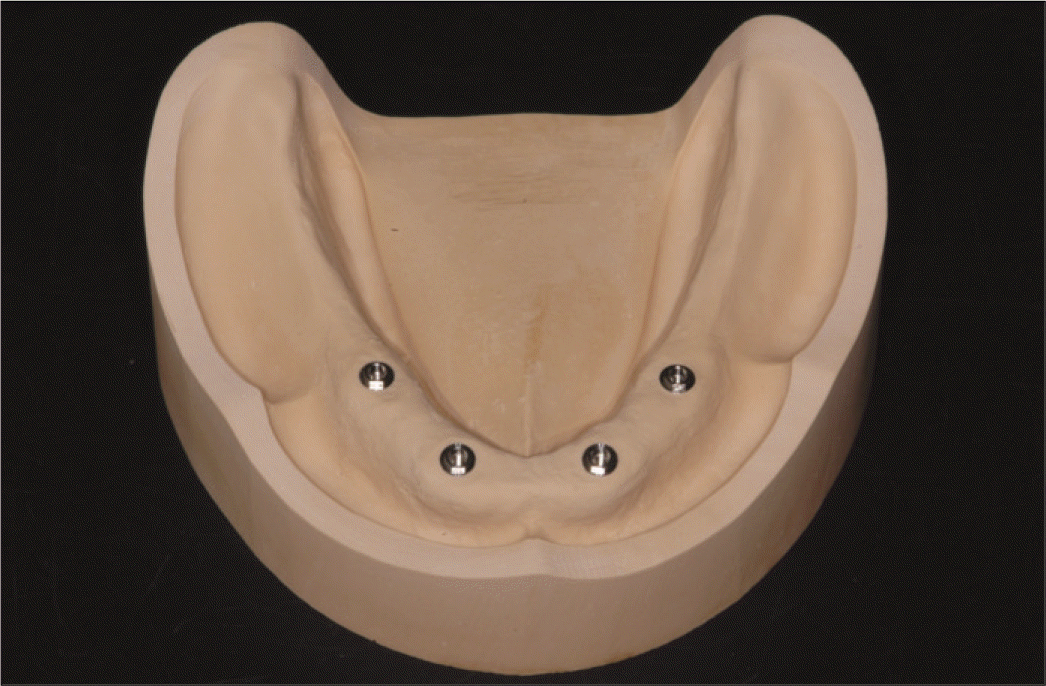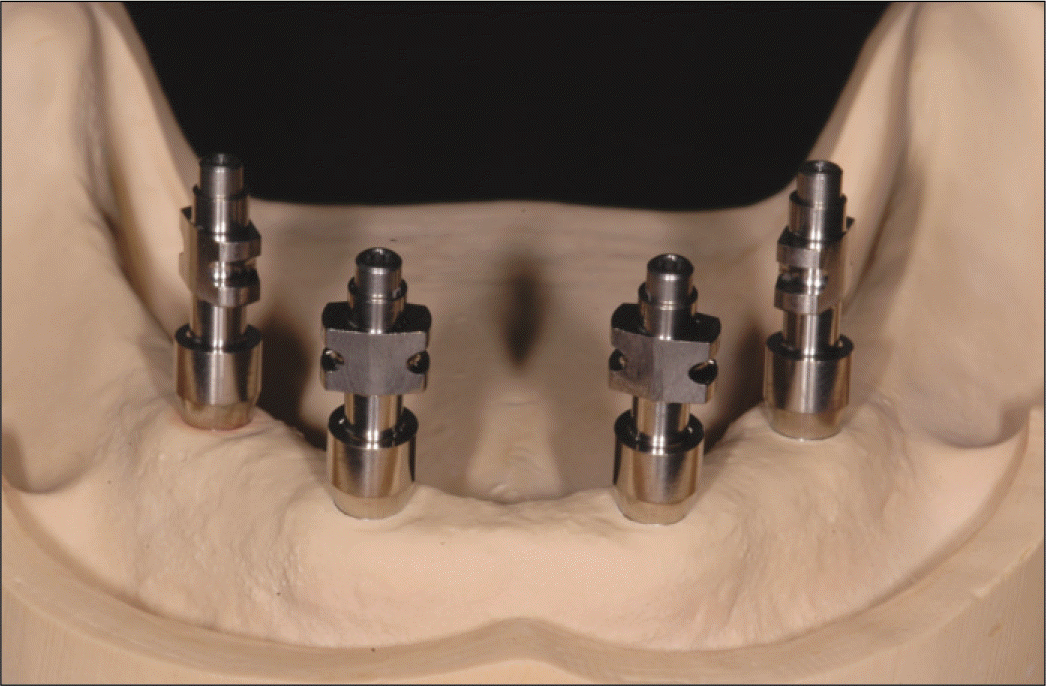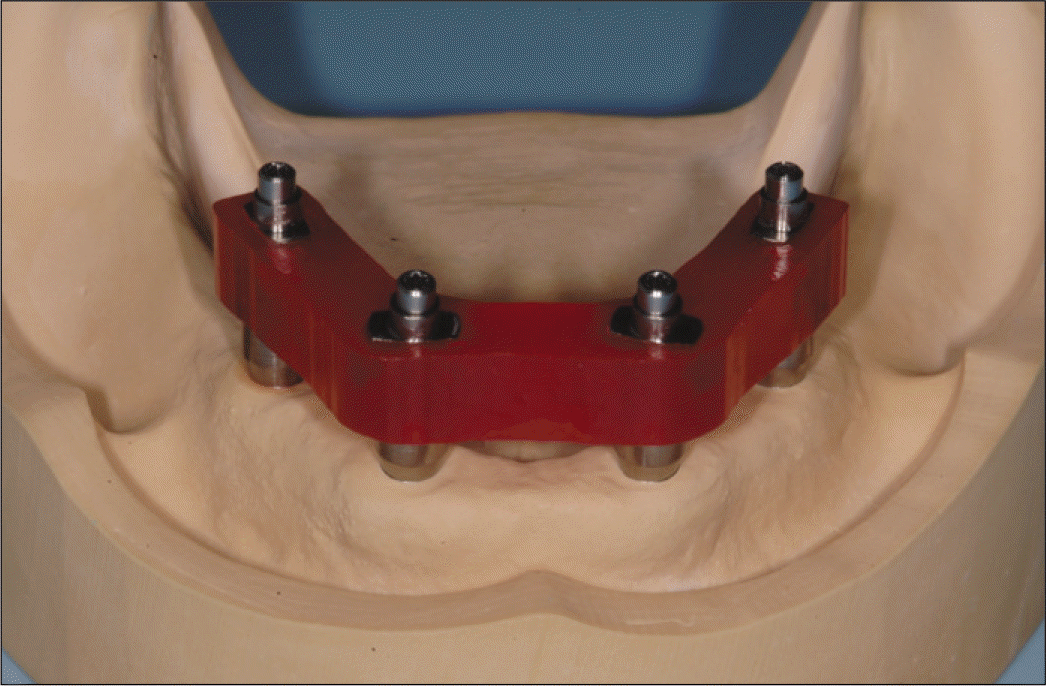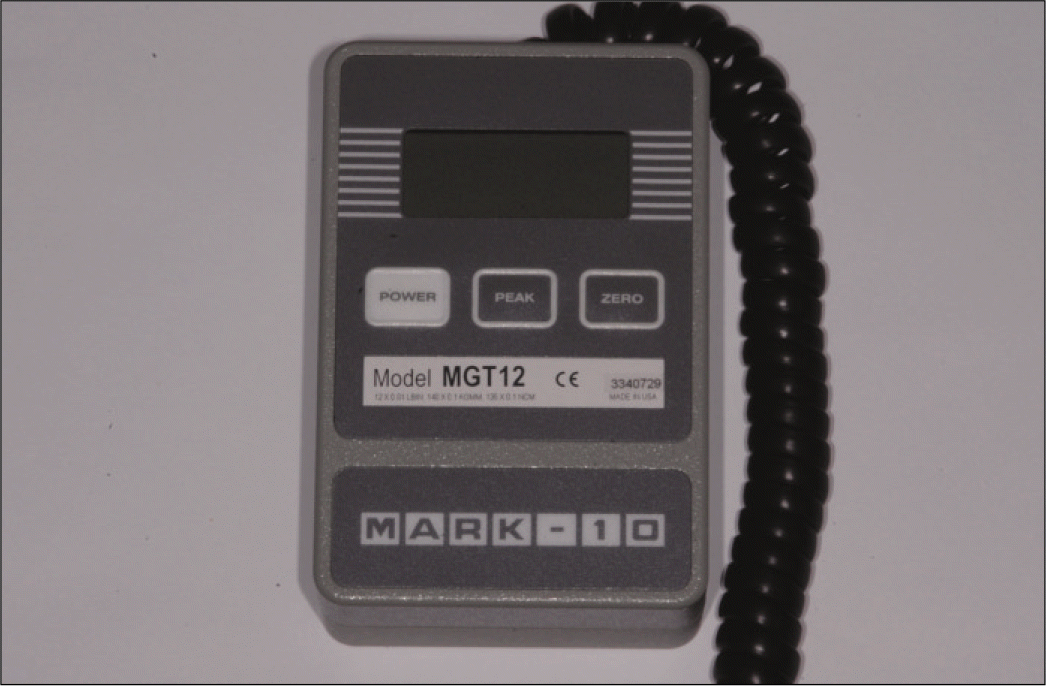Abstract
Purpose
This study evaluated the detorque values of screws in a multiple implant-supported superstructure using stone casts made with 2 different impression techniques.
Material and methods
A fully edentulous mandibular master model and a metal framework directly connected to four implants (Brånemark System®; Nobel Biocare AB) with a passive fit to each other were fabricated. Six experimental stone casts (Group 1) were made with 6 non-splinted impressions on a master cast and another 6 experimental casts (Group 2) were made with 6 acrylic resin splinted impressions. The detorque values of screws (TorqTite® GoldAdapt Abutment Screw; Nobel Biocare AB) were measured twice after the metal framework was fastened onto each experimental stone cast with 20 Ncm torque. Detorque values were analyzed using the mixed model with the fixed effect of screw and reading and the random effect of model for the repeated measured data at a .05 level of significance.
Results
The mean detorque values were 7.9 Ncm (Group 1) and 8.1 Ncm (Group 2), and the mean of minimum detorque values were 6.1 Ncm (Group 1) and 6.5 Ncm (Group 2). No statistically significant differences between 2 groups were found and no statistically significant differences among 4 screws were found for detorque values. No statistically significant differences between 2 groups were also found for minimum detorque values.
Conclusion
In a multiple external hexagon implant-supported prosthesis, no significant differences between 2 groups were found for detorque values and for minimum detorque values. There seems to be no significant differences in screw joint stability between 2 stone cast groups made with 2 different impression techniques. (J Korean Acad Prosthodont 2010;48:280-6)
Go to : 
REFERENCES
1.Worthington P., Bolender CL., Taylor TD. The Swedish system of osseointegrated implants: problems and complications encountered during a 4-year trial period. Int J Oral Maxillofac Implants. 1987. 2:77–84.
3.Patterson EA. Passive fit: Meaning, significance and assessment in relation to implant-supported prostheses. In: Naert EI. passive fit of implant-supported superstructures: Friction or reality? proceedings of an international symposium. Leuven: Leuven University Press;. 1995. 17–28.
4.Sekine H., Komiyama Y., Potta H., Yoshida K. Mobility characteristics and tactile sensitivity of osseointegrated fixture-supporting systems. In: van Steenberghe D, Albrektsson T, Bra�nemark PI, Henry PJ, Holt R, Liden G. Tissue integration in oral and maxillofacial reconstruction. Amsterdam: Excerpta Medica;1986. p. 326–32.
5.Vigolo P., Fonzi F., Majzoub Z., Cordioli G. An evaluation of impression techniques for multiple internal connection implant prostheses. J Prosthet Dent. 2004. 92:470–6.

6.Naconecy MM., Teixeira ER., Shinkai RS., Frasca LC., Cervieri A. Evaluation of the accuracy of 3 transfer techniques for implant-supported prostheses with multiple abutments. Int J Oral Maxillofac Implants. 2004. 19:192–8.
7.Sellers GC. Direct assembly framework for osseointegrated implant prosthesis. J Prosthet Dent. 1989. 62:662–8.

8.Jemt T., Laney WR., Harris D., Henry PJ., Krogh PH Jr., Polizzi G., Zarb GA., Herrmann I. Osseointegrated implants for single tooth replacement: a 1-year report from a multicenter prospective study. Int J Oral Maxillofac Implants. 1991. 6:29–36.
9.Becker W., Becker BE. Replacement of maxillary and mandibular molars with single endosseous implant restorations: a retrospective study. J Prosthet Dent. 1995. 74:51–5.

10.Kreissl ME., Gerds T., Muche R., Heydecke G., Strub JR. Technical complications of implant-supported fixed partial dentures in partially edentulous cases after an average observation period of 5 years. Clin Oral Implants Res. 2007. 18:720–6.

11.Bra ¨gger U., Aeschlimann S., Bu ¨rgin W., Ha ¨mmerle CH., Lang NP. Biological and technical complications and failures with fixed partial dentures (FPD) on implants and teeth after four to five years of function. Clin Oral Implants Res. 2001. 12:26–34.
12.Choi JH., Kim CW., Lim YJ., Kim MJ., Lee SH. The effect of screw tightening sequence and tightening method on the detorque value in implant-supported superstructure. J Korean Acad Prosthodont. 2007. 45:653–64.
14.Henry PJ. An alternative method for the production of accurate casts and occlusal records in osseointegrated implant rehabilitation. J Prosthet Dent. 1987. 58:694–7.

15.Wee AG. Comparison of impression materials for direct multi-implant impressions. J Prosthet Dent. 2000. 83:323–31.

16.Assif D., Marshak B., Schmidt A. Accuracy of implant impression techniques. Int J Oral Maxillofac Implants. 1996. 11:216–22.

17.Haack JE., Sakaguchi RL., Sun T., Coffey JP. Elongation and preload stress in dental implant abutment screws. Int J Oral Maxillofac Implants. 1995. 10:529–36.
18.Martin WC., Woody RD., Miller BH., Miller AW. Implant abutment screw rotations and preloads for four different screw materials and surfaces. J Prosthet Dent. 2001. 86:24–32.

19.Cibirka RM., Nelson SK., Lang BR., Rueggeberg FA. Examination of the implant-abutment interface after fatigue testing. J Prosthet Dent. 2001. 85:268–75.

20.Goldfogel M., Harvey WL., Winter D. Dimensional change of acrylic resin tray materials. J Prosthet Dent. 1985. 54:284–6.

21.Davis GB., Moser JB., Brinsden GI. The bonding properties of elastomer tray adhesives. J Prosthet Dent. 1976. 36:278–85.

22.Revised American Dental Association Specification no. 19 for Nonaqueous, Elastomeric Dental Impression Materials. J Am Dent Assoc. 1977. 94:733–41.
23.Assif D., Fenton A., Zarb G., Schmitt A. Comparative accuracy of implant impression procedures. Int J Periodontics Restorative Dent. 1992. 12:112–21.

24.Jemt T. Failures and complications in 391 consecutively inserted fixed prostheses supported by Bra � nemark implants in edentulous jaws: a study of treatment from the time of prosthesis placement to the first annual checkup. Int J Oral Maxillofac Implants. 1991. 6:270–6.
25.Carr AB. Comparison of impression techniques for a five-implant mandibular model. Int J Oral Maxillofac Implants. 1991. 6:448–55.
26.Barrett MG., de Rijk WG., Burgess JO. The accuracy of six impression techniques for osseointegrated implants. J Prosthodont. 1993. 2:75–82.

27.Zarb GA., Schmitt A. The longitudinal clinical effectiveness of osseointegrated dental implants: the Toronto study. Part III: Problems and complications encountered. J Prosthet Dent. 1990. 64:185–94.

28.Byrne D., Houston F., Cleary R., Claffey N. The fit of cast and prema-chined implant abutments. J Prosthet Dent. 1998. 80:184–92.

29.Carr AB. Comparison of impression techniques for a two-implant 15-degree divergent model. Int J Oral Maxillofac Implants. 1992. 7:468–75.
30.Bartlett DW., Greenwood R., Howe L. The suitability of head-of-implant and conventional abutment impression techniques for implant-retained three unit bridges: an in vitro study. Eur J Prosthodont Restor Dent. 2002. 10:163–6.
31.Binon PP. The effect of implant/abutment hexagonal misfit on screw joint stability. Int J Prosthodont. 1996. 9:149–60.
32.Pietrabissa R., Gionso L., Quaglini V., Di Martino E., Simion M. An in vitro study on compensation of mismatch of screw versus cement-retained implant supported fixed prostheses. Clin Oral Implants Res. 2000. 11:448–57.

33.Rhyu SM., Cho IH., Lim HS., Lim JH. A comparative study on the accuracy of master casts by implant impression techniques. J Korean Acad Prosthodont. 2002. 40:18–29.
34.Hsu CC., Millstein PL., Stein RS. A comparative analysis of the accuracy of implant transfer techniques. J Prosthet Dent. 1993. 69:588–93.

35.Nissan J., Gross M., Shifman A., Assif D. Stress levels for well-fit-ting implant superstructures as a function of tightening force levels, tightening sequence, and different operators. J Prosthet Dent. 2001. 86:20–3.

36.Watanabe F., Uno I., Hata Y., Neuendorff G., Kirsch A. Analysis of stress distribution in a screw-retained implant prosthesis. Int J Oral Maxillofac Implants. 2000. 15:209–18.
37.Kim JM., Han JS., Lee SH., Yang JH., Lee JB., Kim YS. A study of screw loosening after dynamic continous fatigue test of several abutment screw. J Korean Acad Prosthodont. 2003. 41:519–31.
38.Merz BR., Hunenbart S., Belser UC. Mechanics of the implant-abutment connection: an 8-degree taper compared to a butt joint connection. Int J Oral Maxillofac Implants. 2000. 15:519–26.
Go to : 
 | Fig. 1.Master model with four external hexagon implant replicas made from a pickup impression of the superstructure to establish a passive fit relationship. |
Table 1.
Means and SDs in parenthesis of detorque values (Unit: Ncm)
Table 2.
Type 3 tests of fixed effects for detorque values
| Effect | Num DF | Den DF | F value | P-value∗ |
|---|---|---|---|---|
| Group | 1 | 80 | 0.24 | .627 |
| Screw | 3 | 80 | 0.37 | .776 |
| Reading | 1 | 80 | 13.07 | .0005∗ |




 PDF
PDF ePub
ePub Citation
Citation Print
Print





 XML Download
XML Download